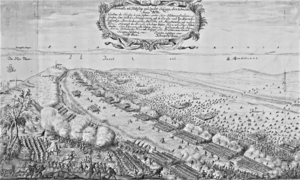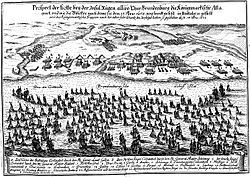Battle of Warksow facts for kids
Quick facts for kids Battle of Warksow |
|||||||
|---|---|---|---|---|---|---|---|
| Part of Scanian War | |||||||
 Battle of Warksow |
|||||||
|
|||||||
| Belligerents | |||||||
| Commanders and leaders | |||||||
| Strength | |||||||
|
3,500: 2,000 cavalry |
4,670: 1,770 cavalry |
||||||
| Casualties and losses | |||||||
|
about 170 killed and wounded |
4,000: 3,600 captured |
||||||
The Battle of Warksow was an important fight during the Scanian War. It happened on the island of Rügen in the Baltic Sea on January 18, 1678. In this battle, Swedish forces fought against an army made up mostly of Danes, with some soldiers from Brandenburg and Hesse-Cassel.
The Swedish army had about 3,500 soldiers, including 2,000 cavalry (soldiers on horseback). The combined Danish and Brandenburg forces had about 4,670 soldiers. This included 1,770 cavalry and 16 cannons.
About 170 Swedish soldiers were killed or wounded. On the other side, 400 Danish and Brandenburg soldiers were killed, and over 3,600 were captured. After the battle, most of the allied army was either captured or forced to join the Swedish side.
Contents
Why the Battle Happened
Sweden's Role in the War
In 1675, Sweden was a very strong military power. The French king, Louis XIV, asked Sweden to declare war on Brandenburg-Prussia. This was because Brandenburg-Prussia was already fighting France in another war called the Dutch War.
After a Swedish army lost the Battle of Fehrbellin in 1675, Sweden had to defend its own lands. Its areas in northern Germany, called Swedish Pomerania, were now in danger. Denmark and Brandenburg-Prussia had formed an alliance against Sweden.
In 1677, the Swedish navy suffered a huge loss. The Danish fleet, led by Admiral Niels Juel, almost completely destroyed it in the Battle of Køge Bay. This meant that the island of Rügen, which belonged to Sweden, was now cut off. The Danish navy controlled the Baltic Sea, so no help could reach Rügen from Sweden.
Denmark's Plan to Take Rügen
After their naval victory, the King of Denmark, Christian V, decided to capture Rügen. He saw it as a necessary step before attacking the important fort of Stralsund on the nearby mainland. Denmark and Brandenburg-Prussia had agreed that Rügen would go to Denmark after the war.
On September 17, 1677, Danish troops landed on Rügen. They had about 4,200 men and faced no resistance. The Swedish general, Otto Wilhelm von Königsmarck, didn't expect an invasion. Most of his soldiers were inside Stralsund, which was under siege.
So, the Danes were able to set up their defenses without trouble. Later, more Brandenburg cavalry joined them. They then moved towards the Swedish troops who had come to Rügen and were near Bergen. The Swedes lost the Battle of Bergen and had to retreat. Eventually, they left Rügen completely and went to Stralsund. Only one small fort, the Prosnitzer Schanze, remained in Swedish hands.
Island's Struggles and Swedish Counter-Attack
The island of Rügen had been heavily impacted by the fighting. It was hard to find enough food and supplies for the soldiers. On October 21, the Danish king returned to Denmark. Many Brandenburg troops also left the island, leaving only 970 men.
The remaining Danish and Brandenburg troops were led by Major General von Rumohr and Colonel Wilhelm Friedrich von Hülsen. They were told not to fight the Swedes until more soldiers arrived. However, no more Danish soldiers came, as many were sick.
The Swedish commander, Field Marshal Otto Wilhelm von Konigsmark, saw this as a good chance to take Rügen back. In January 1678, he brought his 3,500 soldiers from Brandshagen to the island. They landed at the Neufährschanze fort, which was still held by the Swedes.
How the Battle Unfolded
Even though they were told not to, the allied Danish and Brandenburg forces decided to fight. Major General von Rumohr led them. The battle started at 9 in the morning with cannons firing. This happened on the road between Poseritz and Gustow, near Warksow Manor.
When Detlef von Rumohr, the allied commander, was hit by a cannonball, his soldiers became confused. Seeing this, the Swedish general, Konigsmark, ordered his troops to attack. The Swedish right side attacked the Brandenburg cavalry. The Brandenburg cavalry managed to push back the Swedish cavalry at first. But then, the Swedish cavalry regrouped and got help from their reserves, pushing the Brandenburg cavalry back.
The Brandenburg troops tried to fight back again. However, they didn't get much help from the Danes. Because of this, the Swedes, who had more soldiers, pushed them back once more. Swedish forces then attacked the Danish soldiers from the side and behind. The Danes lost their courage and ran away in all directions. The Swedes managed to capture almost all the Danish foot soldiers. After four hours of fighting, the Swedes had won a clear victory.
What Happened After the Battle

The day after the battle, the Swedes took over Bergen. They chased the fleeing enemy towards Jasmund and Wittow, capturing the last of the allied soldiers there. The captured soldiers were made to join the Swedish army and serve on Rügen. So, Rügen became Swedish again for a short time.
However, the Danish and Brandenburg allies quickly recovered from this loss. During the summer of 1678, the Danes attacked Rügen several times. Both the Danes and Brandenburgians also planned a new mission to take Rügen back. The new invasion of Rügen began on September 23, 1678. Brandenburg troops landed on the island again and recaptured it within two days. The prisoners from the Battle of Warksow, who had been forced to join the Swedish army, gave up the Neuefähr fort to the Brandenburg invasion forces without a fight.
See also
- Wars and battles involving Prussia
Images for kids





